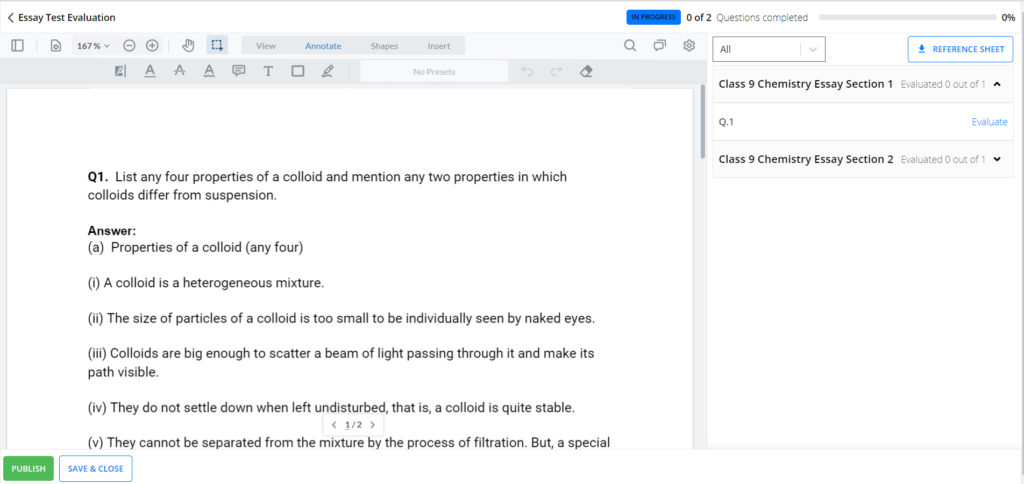What is Digital Evaluation System: How to implement it in your college?
- January 12 2021
- Vaishak

The Digital evaluation system makes your testing process a lot simpler and comfortable. With online classes on the rise, more and more digital transformation is taking place in every aspect of e-learning. According to statistics, 82% of the students find digital technology to help improve their grades.
Evaluation is a critical component of any test. It gives us the exact data about the students’ performance in a particular test through their scores. With this, you can infer the various areas of their improvement. For a long time, the evaluation process was done manually. In large-scale examinations, it often turned out to be quite time-consuming.
Luckily, with most of the tests conducted digitally these days, the evaluation process has also turned digital and, more importantly, automated. In this blog post, you will know more about the digital evaluation process and how to set one in your college.
What is a digital Evaluation system?
Digital evaluation is nothing short of a huge revolution in the field of e-learning. With an increasing demand for online exams, it was essential to have an effective digital evaluation system in place alongside it. Since most of the online exams were conducted based on the MCQ format, it was easy to implement a digital evaluation system. Evaluating the answer sheets and producing accurate results became quicker and more effective.
In India, the Central Board of Secondary Education laid the foundation stone for online exams and sowed the seeds for an efficient digital evaluation system. There are several institutes across the nation that are now following this system.
How does a digital evaluation system work?
Digital evaluation not only applies to online tests but also to paper-based examinations. Surprised? Remember the Optical mark reading sheet? That is the earliest form of a digital evaluation system. Students had to shade the right answer with a pen or a pencil on the sheet. After that, the sheets are scanned using an optical scanning device that feeds the data to the system for further study. The system will later analyze the correct answer and give the result.
The use of OMR sheets is one of the oldest digital evaluation systems in practice. Today, newer technologies like Artificial Intelligence and Machine Learning are taking the front seat in e-learning. Incorporate these powerful technologies into your evaluation system to have a whole new experience of test evaluation.
China has implemented an AI-based evaluation system for assessing multiple test papers. It consists of a machine learning algorithm that reads the answer text and grades them, along with a feedback mechanism to highlight areas of improvement.
Some systems can even understand students’ handwriting and evaluate accurately. The occurrence of errors is also very minimal and is non-repeatable. Moreover, the time taken by the AI system to evaluate one answer sheet is less than a minute, which is nowhere close to the manual evaluation.
Advantages of a digital evaluation system
The below-mentioned are some advantages of the digital evaluation system. You can enjoy these merits while implementing such a system in your academy or college –
Convenience – It is easy to use even with basic computer knowledge. Apart from question creation, complex marking is also made easier and simpler with the digitization process.
Security – Digital evaluation system offers high security in storing student data. There is minimal chance of leaking the results in such systems.
Scalability – Digital evaluation promises increased capacity compared to manual evaluation practices. The number of answer sheets that can be evaluated increases greatly with the digital evaluation system.
Accuracy – Manual evaluation tends to have human errors, especially when the number of papers to evaluate is high. You eliminate this with the digital evaluation system, where the totaling of marks is automated.
Unbiased – A hint of bias can always creep in with a manual correction process. Teachers can be biased towards a student they like. There is no room for such unfair practices within the digital system. This proves to be a great advantage for institutes to evaluate the capabilities of a student correctly.
Implementing a Digital Evaluation System
Now that you know the benefits of the digital evaluation system, you might be eager to implement it in your college. To help you effortlessly implement it, we have listed out a detailed step-by-step process –
Step 1: Identify Goals
The first step in creating a digital evaluation system is to identify your academy’s goals and its strength. Find out the problems you are constantly facing and list out the most common issues. This is mandatory because investing in digital evaluation should never go to the mud. Discuss with your staff members the common issues they are facing while evaluating the answer sheets.
Step 2: Plan for resources
Once you have identified the goals, you have to start planning for the necessary resources. Resources include digital scanners, Learning management software, high-speed computer systems, AI-powered tools, and so on. Identify the tools that fit your budget and needs.
Step 3: Trial run the system
Have a sample test conducted with a small group of students. Check for the software and the devices thoroughly. If you are planning to adopt an Optical Mark reading-based test, scan the answer sheets and feed them to the computer system. The system scans the text using its AI-powered software and checks for the right and wrong answers. Evaluators can grade the answers based on the system’s suggestions displayed onscreen.
In the case of paper-based exams, the software should also be capable of reading and reducing blank pages so that the examiners need not waste time looking for them. Perform the trial run repeatedly to eradicate unwanted issues and have a clean system.
Step 4: Incorporate a training session
Any digital tool might be new to the users initially. Hence it is important to teach them the technology that they are going to use. Organize a training session for the staff members to make them familiarize with the technology and its benefits. This gives them a sense of control and the ability to handle the system with confidence.
Step 5: Launch the system
After various trials and well-organized training for the teachers, it is time to launch the system into action. Implement the digital evaluation system in practice and see its benefits displaying in front of your eyes. Monitor the system continuously for its performance and review it frequently to upgrade it with the latest features. It is advisable to have a contingency plan if there is a fault with the system so that there is no obstacle to work until it gets repaired.
How does Learnyst help?
Learnyst is software that helps create courses, conduct tests, and analyze your students’ performance. With Learnyst Test Maker software, you can create online tests for your students. The Test Maker software is not only a platform for conducting and attending tests but also a digital evaluation platform. As soon as the test is submitted by the student, the app displays the result on the screen along with points for improvement and the areas in which the student needs to focus more. This reduces time and effort for the teacher drastically in correcting the answers scripts manually. To know more about Learnyst Test Maker, click here.
What’s Next?
The digital evaluation system is a next-gen technology and will prosper with new developments in the e-learning industry. Upgrade your college to the next level using Learnyst and its Test maker software.


Leave your thought here